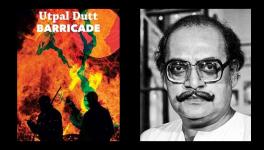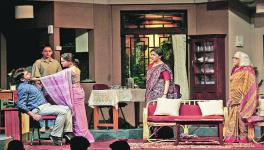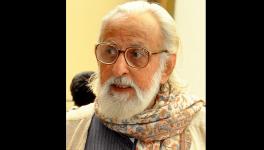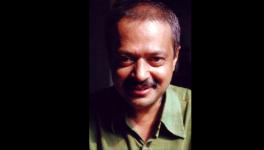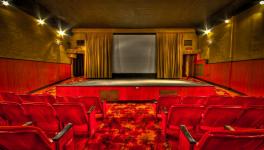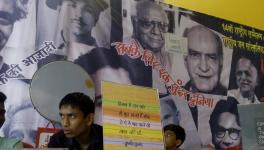Breaking Silences Makes Civilisations Heal: Theatre Director, Sunil Shanbag
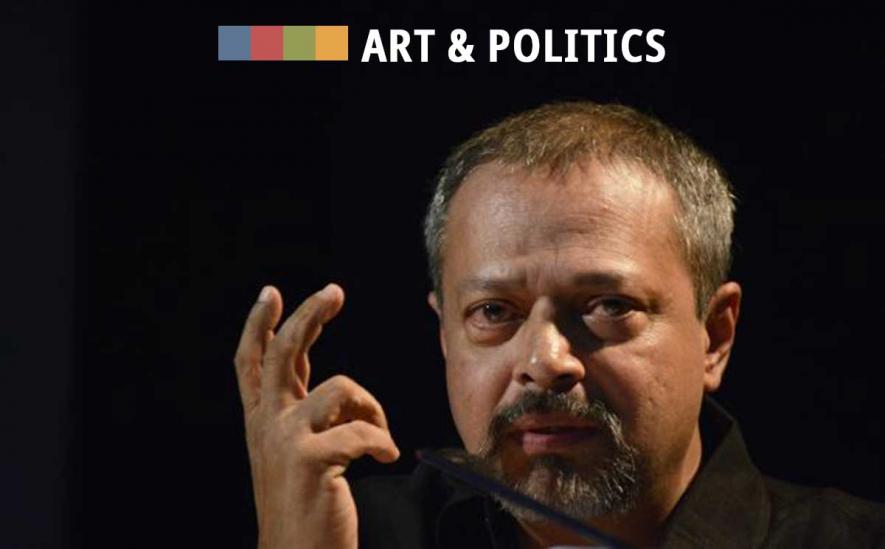
June 2023
Over the past weeks we have been performing our play Words Have Been Uttered (WHBU), which is an exploration of the idea of dissent. It’s not structured as a conventional play (one major theatre festival in India even rejected it because it didn’t fit into their definition of a theatre piece).
WHBU is eight of us, actors, and a musician, sitting in a shallow semi-circle, with our books, our texts, and musical instruments sharing with the audience a diverse selection of creative expressions of dissent. We read, recite, sing, and perform scenes from theatre, poetry, songs, satirical pieces, and even personal writings from across time, across cultures, across languages. These amazing texts question caste, gender, organized religion, superstition, authoritarianism, majoritarianism, notions of nationalism and much more, illuminating how nuanced the idea of dissent is, and how universal it is.
I usually introduce the evening to the audience to prepare them for what is to follow, and while doing so I acknowledge that the while the idea of dissent in our times seems particularly loaded and edgy, it has always been so. It is not easy for any society to deal with dissent, and it requires maturity and tremendous self-belief to engage with dissent in a positive and constructive way. Ideas need space to be aired, and people who are willing to listen. We need to be able to listen, agree, or disagree, and move on without fear of violence, humiliation, and threat.
We all agree that such spaces are shrinking, and we believe that theatre, in a fundamental way, offers such a space. The isolation of Covid-19 times brought into sharp focus what it means to be able to assemble and engage with live performance. A space where you enter as an individual and very quickly become a part of a group of people sharing a unique moment. Theatre is about story-telling, about personal experiences, and the use of metaphor. The mode of communication can be nuanced and appeal to mind and to the heart. Such a space can nurture ideas and open conversations – and be a radical counter to the frightening culture of hate, intolerance, violence and majoritarianism that we see around us. The overall response to Words Have Been Uttered by different kinds of audience validates this belief.
We are faced with challenges all the time whether it is censorship, cynicism, or of the threat of recrimination from the state. But the biggest enemy of arts practitioners which is perhaps the most difficult to overcome is self-censorship.
Over the past 10 to 15 years our work at Theatre Arpana, and Tamaasha Theatre has been across various genres of theatre practice and has been engaging with and presenting the complex nature of contemporary India, in conventional theatre spaces as well as in various alternative spaces. The work spans across themes and issues that concern modern Indian society, across class, caste, gender and other inequalities. Our choice of work has been possible because of an understanding of the theatre ecosystem in India, careful strategising, and a belief that theatre can respond to our times without losing out on audience engagement, and in fact, by celebrating the human spirit.
We may then wonder why the potential of theatre to play this role is not explored often enough. There are many different reasons why people make theatre. There is a large theatre practice which believes that theatre has to entertain and no more, a conviction shared with practitioners of other forms like cinema. Unfortunately, the accepted norm is that entertainment and meaningful work cannot go hand in hand. This is not a place to argue that point, but I will add that cross overs have been tried, and several have succeeded. There are many examples in Marathi language theatre for instance where plays and theatre makers, both, have straddled the worlds of commerce and artistic practice. In our own work we have deliberately tried to place “our kind” of theatre thinking in mainstream spaces, and while we may not have been able to sustain this over time, our attempts have not been entirely unsuccessful.
Our 2012 production of Ramu Ramnathan’s play Cotton 56, Polyester 84 was a re-telling of the history of the textile mill workers of Mumbai. Told by two out of work mill workers, the play was developed by Ramu based on interviews with mill workers and their families, from court room trials where textile trade unions fought the powerful mill owners to secure the rights of mill workers, and Meena Menon and Neera Adarkar’s oral history of the history of Mumbai’s textile mills and trade unions. The play brought to light the suppressed history, subculture and marginalisation of the mill workers of Mumbai, whose plight was largely ignored in the raging public debate on the development of the mill lands.
As you can imagine Cotton 56 could be no stretch of imagination be called a conventional entertainer, and yet audiences in Mumbai and across the country responded to the play both intellectually and emotionally.
A few years later we made Sex, Morality, and Censorship written by Shanta Gokhale and Irawati Karnik, which dealt with the idea of censorship by examining the censorship of Vijay Tendulkar’s play Sakharam Binder in 1972. Using archival material from India and abroad, theatre history, arguments and scenes from Sakharam Binder, the play was again not conventional story telling. As a director I was very aware that we were constructing an argument about censorship of a play in the context of its times. Sex, Morality and Censorship went on to perform across the country, often in large auditoria, engaging with diverse audiences who seemed to connect to the ideas of the play.
In Loretta we adapted the colourful Goan Tiatr tradition to talk about narrow parochialism, language and identity, and linguistic purity and hybridity. This at a time when we were being asked to prove our “Indian-ness” by the rapidly growing ranks of right wing bhakts.
In Words Have Been Uttered we tried to push our own boundaries further by dispensing with frills and narrative support devices, and concentrate purely on the core idea of the play – dissent.
These and several other examples have convinced us that even audiences whose only exposure is to the conventions of mainstream theatre can surprise you with their acceptance of new ideas, non-conventional forms of theatre making. Unfortunately, there are gate keepers, in our own community, who show scant respect for audience “intelligence” and perpetuate the myth that audiences are not willing to engage with plays that have a more meaningful intent.
It is within the ecosystem of “smaller theatre” you are more likely to find work that is artistic in intent and responds to the time. The is the space we largely inhabit for a variety of reasons. To begin with, the economics and availability of smaller spaces are manageable. Often audiences that come to smaller plays and spaces are seeking something different, and hence are more open to new ideas and conventions. That’s half our battle won.
The downside? We get comfortable, even complacent, in a safe space, and you may be “preaching to the converted”. Of course, gatherings like these have importance too. There is tremendous value in people who share similar beliefs gathering and experiencing something that validates, or expands, the world of ideas they subscribe to. We know this doesn’t happen enough, and we must be careful not to take a cynical view of this. But the need to reach out to new audiences is critical, and difficult as it maybe, there is not getting away from it.
When we founded Tamaasha Theatre about ten years ago we did so with the clearly stated intent of working outside conventional theatre spaces, creating a theatre of ideas, and forging a different relationship with an audience. We expanded our definition of theatre beyond merely producing and performing plays, to training, study, and audience building.
Audience building is one of the most important aspects of theatre practice. This is not about merely publicising your performances where you look to get an audience into the performance space. It’s about building a longer-term relationship with people so that they see themselves as co-travellers in your journey. When we build audiences we also look to create diversity so that a broader representation of society engages with the work and ideas. Various strategies help this – pricing of shows, open sharing of ideas, diverse programming to cater to specific interest and so on.
We run a studio space in Mumbai, as an arts centre, where theatre practitioners, students, musicians, and occasionally dancers can meet, make work, and perform for audiences that are enthusiastic about engaging with the arts in more than a passive way. In the last few years, we have often asked ourselves, how do we respond to the times. There is our own need, and also an expectation from our audiences and from our larger community.
These are our some of our dilemmas:
The space available for alternatives views, ideologies, and thoughts has always been limited, but in more recent times the situation has become much more fraught. It doesn’t take much for someone to take objection to a piece of work, or a thought, and for the authorities to slap rather serious charges on the hapless “offender”
We are not activists, so are we psychologically and otherwise prepared for this kind of an eventuality?
On the other hand, today more than ever before, the need for alternative narratives is critical.
Why do artists have an added responsibility? Can art provide the nuances that journalism cannot? Even the best of journalism? Can art resist the numbing influence of the mainstream? We believe the answer to both is yes.
And two events that took place at our studio validated this belief.
The first was when we did an evening of Urdu texts – poetry and fiction – that dealt with different ideas of Kashmir. The texts were written by some well-known writers both from within Kashmir, and outside, and some less known voices. As you can imagine, the evening was somewhat tense for us. We are open to all audiences and we exercise no control on who attends. There is a degree of unpredictability to an evening such as this. But as the texts unfolded within the framework of a context which was both literary and political, we sensed a mood of deep involvement and thoughtfulness in the audience. There was emotion, there was humour, there was on offer many ways of seeing a land, a culture, and a people over time. In the post reading discussion that followed we saw restraint and responsibility in the way people spoke. Not all views were similar, but everyone heard the other out, and discussion flowed outside the venue into our open terrace space.
On another evening we had a rendering of texts from Palestine and Syria, but we were careful to frame it within the context of a land under occupation, and how common images and ideas are often found in the cultural expressions of people under siege.
This time in the post-performance discussion, after the first polite questions, a dam seemed to burst, and there was an animated discussion. A sense of relief at being able to speak was palpable in the room. This time connections were made to radical poetry from other parts of India and the world. There was an honesty and open-ness that was powerful.
We really are in no position to understand what happens after an evening like this. Perhaps the conversations are forgotten, perhaps they remain. It’s hard to say. Also, we have touched no more than 40 people in an evening. A tiny, tiny micro drop in our vast ocean. Are we deluding ourselves about the impact?
Difficult questions …
For those of us who learnt our theatre fundamentals in the 1970s and 1980s the times we lived in had a deep impact on our view of theatre. This was a turbulent period — the great railway strike in 1974, Jayprakash Narayan’s “total revolution” which led to the clamping of Emergency by Indira Gandhi, the birth of the human rights movement, emergence of the Dalit Panther party, and the textile strike of 1982. It was very clear to us that your work wouldn’t be taken seriously if it did not respond to its times. Today the situation is more fraught because authoritarianism is highly visible and resistance to it virtually invisible. There seems endless darkness. But we often remind ourselves of the inspiring words of the great writer Toni Morrison,
“This is precisely the time when artists go to work. There is no time for despair, no place for self-pity, no need for silence, no room for fear. We speak, we write, we do language. That is how civilizations heal.”
(Sunil Shanbag is a Mumbai based theatre director and producer. He is the co-founder and artistic director of Theatre Arpana, and Tamaasha Theatre. Over the past 45 years, Sunil’s work spans across themes and issues that concern modern Indian society, across class, caste, gender and other inequalities)
Get the latest reports & analysis with people's perspective on Protests, movements & deep analytical videos, discussions of the current affairs in your Telegram app. Subscribe to NewsClick's Telegram channel & get Real-Time updates on stories, as they get published on our website.










